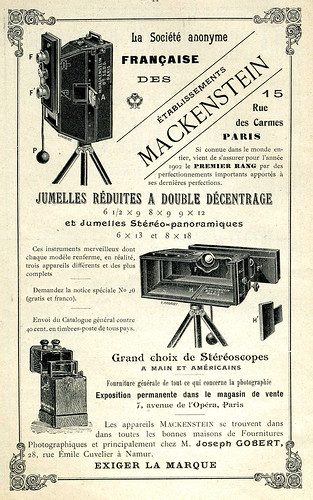Mackenstein jumelle cameras

|
| Advertisement in Le Photo-Revue Belge, 1902 scan by Romuald Swieconek (Image rights) |
The Jumelle Stéreo-panoramique is a jumelle type camera for 6x13 cm or 8x18 cm plates, made by Mackenstein of Paris in about 1900. It is a typical stero jumelle camera. It is wooden-bodied, with leather covering. It has a guillotine shutter, with several instantaneous speeds, plus 'B' ('Pose'), behind the lenses. There is an external rod linkage on the lens board, connecting the aperture controls of the lenses. The lens board allows front rise. It also slides sideways; this is not for perspective control, but to allow one of the lenses to be placed centrally, for panoramic photographs using the whole stereo plate. For such use, the septum dividing the camera inside would be removed (shown in the advertisement illustrated). There is a Newton finder on top of the camera. In an example seen at Westlicht,[1] the finder is mounted on a track and can slide sideways, presumably to position it for separate (mono) exposures on each half of the plate (with one of the lenses capped). The plates are held in a removable magazine back.
Notes
- ↑ 8x18 cm stereo-panoramic jumelle camera (listed by Westlicht as 9x18) with 110 mm f/8 Krauss-Zeiss Protar lenses, sold at the May 2011 Westlicht Photographica Auction.